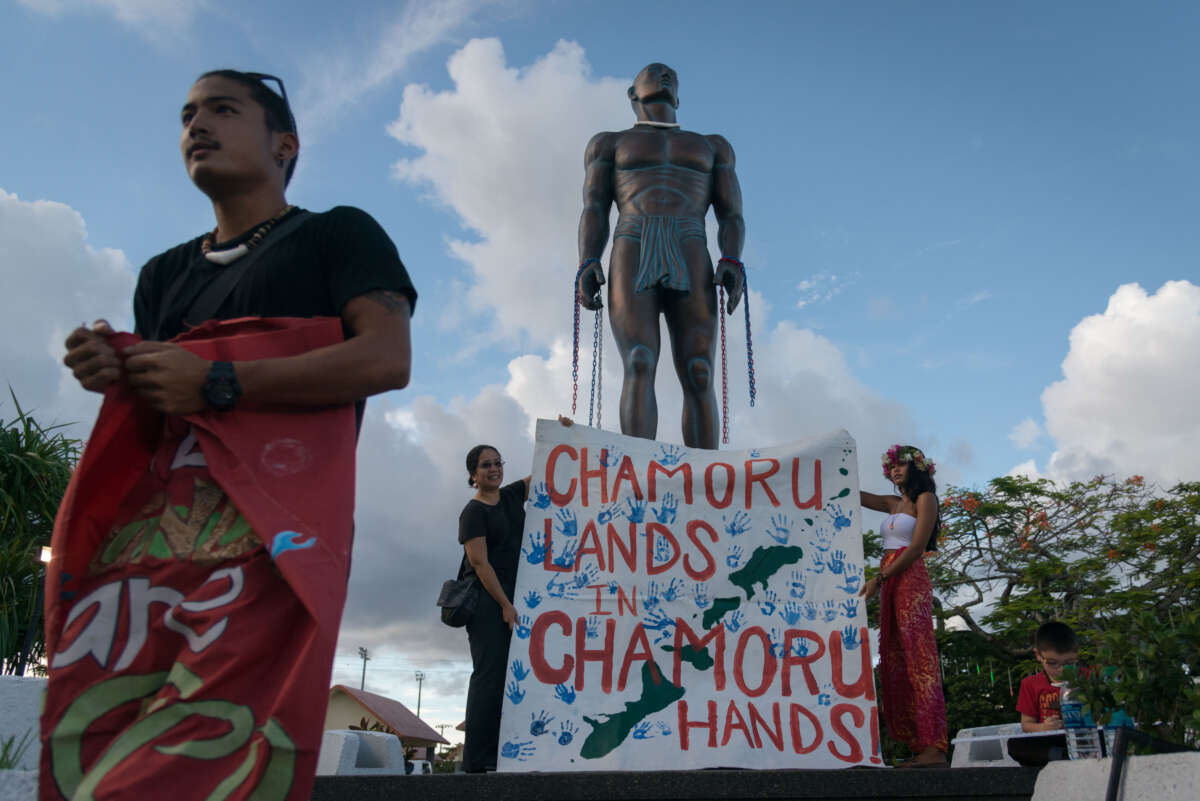The Indigenous Pacific Islander community in Guam — known as CHamorus — has long called out the United States military for the environmental and cultural damage enacted on their homeland. This process of occupation and destruction began when Guam was colonized in 1898 and continues to this day, as nearly one-third of the 30-mile long island remains occupied by the U.S. military.
Several years ago, I traveled to Guam on a reporting fellowship and spoke with CHamoru community members about the sacred area of Litekyan, located on the northwestern coast of the island. Among the idyllic white sands, lush forests and turquoise waters, lie two imminent threats to CHamoru land: a live-fire training range complex and an open burning and detonation zone.
The firing range was built to train approximately 5,000 U.S. Marines being relocated to Guam from Okinawa, Japan. The Marines, who started arriving to Guam in 2023, are stationed at nearby Camp Blaz where more than 1,000 acres of limestone forests were destroyed to create the base. Nearly 4,000 acres of land on Andersen Air Force Base will be used for the range and more than 5 million rounds of ammunition will be fired every year.
Parts of Litekyan and the open ocean lie in the surface danger zone, where munitions could ricochet or land. These munitions, such as bullets from machine guns, contain a range of heavy metals, including lead. Over time, lead from these bullets can accumulate in the soil and eventually contaminate the aquifer located below the firing range. Guam only has one aquifer that supplies 80 percent of all drinking water to its residents, meaning contamination of the aquifer could threaten access to clean drinking water across much of the island.
Along with environmental contamination, the firing range poses direct threats to the ancestral and cultural heritage of the CHamoru people. At least 20 archeological sites listed in the National Registry of Historic Places could also be directly and adversely impacted by this military project. And while the Department of Defense put $12 million toward establishing a cultural repository, this will result in the disinterment of CHamoru remains from their original and sacred burial grounds. When I discussed this with a community member, she pointed to a nearby rock lightly covered with moss and said, “It’s like the moss. You don’t take that and put that in a repository. It’s not going to thrive in the same way.”
In addition to the firing range, the U.S. Air Force applied to renew a permit with the Guam Environmental Protection Agency that would allow them to openly burn and openly detonate (OB/OD) 35,000 pounds of bombs and other munitions on Tarague Beach, another Indigenous area in Litekyan. These munitions, classified as reactive hazardous wastes, are largely leftover from World War II. The presence and disposal of this waste can release toxic vapors, with the potential to cause respiratory problems, skin irritation, and in more severe cases, cancer.
CHamoru community members are currently engaged in a federal lawsuit against the U.S. Air Force. The lawsuit cites that Anderson Air Force Base failed to conduct a proper analysis of the environmental impacts of OB/OD operations and did not consider other alternatives for disposal. According to Monaeka Flores, a CHamoru organizer involved in the lawsuit, the OB/OD site is “close to everything. Migratory birds, sea turtles, fisheries … traditional medicines that grow in that area … and our water of course.” Similar to the firing range, the OB/OD site lies above Guam’s aquifer. Detonation of munitions could contaminate the land with heavy metals and toxic “forever” chemicals like PFAS, which may leach into the groundwater below.
In March 2024, the U.S. Environmental Protection Agency released a proposed update to their OB/OD guidance — the first revision since the 1980s — stating that OB/OD facilities must consider alternatives for treating these types of hazardous waste. Various alternative treatment technologies exist, including removing the reactive material or freezing and fracturing the munition. However, until the U.S. Air Force properly evaluates (and implements) alternative methods at the site, open detonation will continue to be allowed at Tarague Beach.
Community members across Guam have been speaking out against these military projects for generations, demanding an end to the environmental destruction and the return of their Indigenous land. Nonprofits like Prutehi Litekyan are actively working to stop the firing range and OB/OD activities by educating community members, organizing protests, circulating petitions and writing letters to policy makers.
For many CHamorus, resisting militarization is part of a larger vision to decolonize Guam and regain their sovereignty. Since 1946, Guam has been listed by the United Nations as a nonself-governing territory, meaning they lack full self-determination. For example, Guam residents cannot vote in U.S. presidential elections and they do not have voting representation in Congress. Groups like Independent Guåhan have organized CHamoru members to testify at the United Nations to speak about decolonization and the environmental impacts of more than a century of U.S. militarization.
What’s happening in Guam is just one example among many across the country, and the world, of the work of Indigenous people to secure and reclaim rights to their homeland.
As we close out Asian Pacific Islander Heritage month, we must stand behind the Indigenous people of Guam and other Pacific Islanders living in the U.S. territories in their fight against the ongoing militarization of their occupied homeland.
Media that fights fascism
Truthout is funded almost entirely by readers — that’s why we can speak truth to power and cut against the mainstream narrative. But independent journalists at Truthout face mounting political repression under Trump.
We rely on your support to survive McCarthyist censorship. Please make a tax-deductible one-time or monthly donation.
